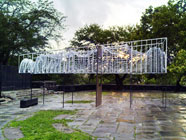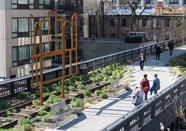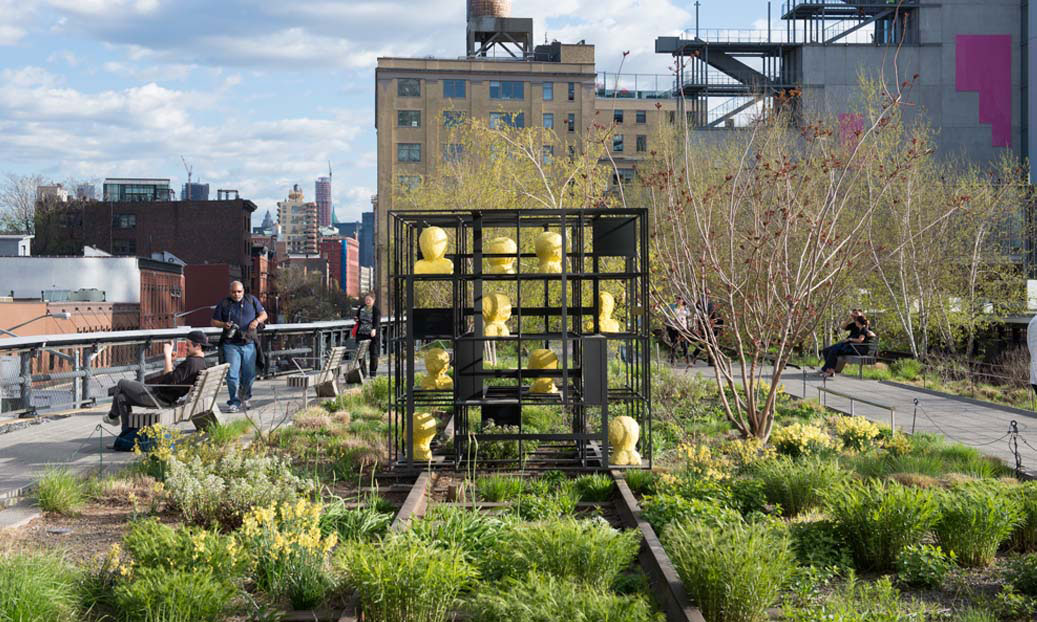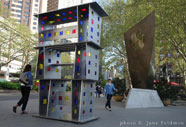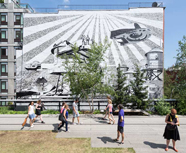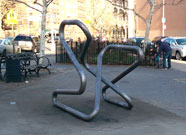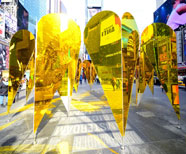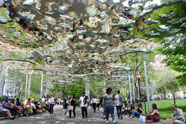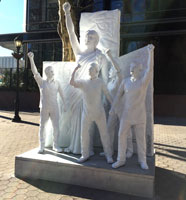Art in the Parks
Through collaborations with a diverse group of arts organizations and artists, Parks brings to the public both experimental and traditional art in many park locations. Please browse our list of current exhibits and our archives of past exhibits below. You can also see past grant opportunities or read more about the Art in the Parks Program.
Public Art Map and Guide
Find out which current exhibits are on display near you, and browse our permanent monument collection.
Search Current and Past Exhibits
2016
Manhattan
Jessica Feldman, Jerome W Haferd & K Brandt Knapp, caesura: a forum
June 20, 2015 to April 15, 2016
Marcus Garvey Park, Manhattan
Map/Directions (in Google Maps)
Please note: This is a past exhibit that is no longer installed in the park.
Located on the Acropolis of Marcus Garvey Park, caesura: a forum by artist Jessica Feldman and architects Jerome W Haferd & K Brandt Knapp is inspired by the park’s iconic antebellum Mount Morris Fire Watchtower, and by Harlem’s vibrant tradition of activism and rallies. The bell is silent now, as the tower was temporarily dismantled in 2015 as the first phase for its reconstruction. Simultaneously, Harlem is undergoing dynamic change and New York City is experiencing a resurgence of public culture. caesura seeks to temporarily fill an architectural gap – and create a social space – by echoing and inverting the form and function of the absent tower. Like the bell, caesura aims to call up the neighborhood, to preserve and revitalize Harlem’s histories, and to connect newer and older community members to each other, by reactivating this site for congregation, viewing, and listening. The installation will reframe history with a temporary structure and sound. A “caesura” is a break or pause, a place to catch your breath, most specifically in ancient spoken-word art.
The architectural component of this piece begins at the Acropolis ground as an open-air, steel frame that supports a “horizontal tower”, which the viewer can pass through and meander under. In the center of the piece, a flattened “bell” made of reflective steel.
The sonic component of the piece consists of Feldman’s interactive composition, made up of bell sounds and voices. Historical and contemporary recordings and live-streaming voices from speeches, rallies, chants, and assemblies in Harlem are alternated with a through-composed layer of echoing bells. Analogous to a megaphone, the formal profile of the tower has been tipped sideways, allowing sound to be projected outward. Taut, translucent film runs through this shape and is mounted with electromagnetic transducers that turn the material into a speaker, allowing sound to pour down from the spaces in between the arches above visitors. A microphone mounted at the entrance to the installation allows visitors to broadcast their own voices through the piece. Those not present can participate through an interactive online component, allowing them to trigger the bell and contribute their own live audio to the arches. New and old histories are recorded, spliced, and digitally scripted together, activating the acropolis throughout the day.
This exhibition is co-presented with the Harlem Arts Festival, Marcus Garvey Park Alliance, and Mount Morris Park Community Improvement Association (MMPCIA).
![]()
Various Artists, Panorama
April 23, 2015 to March 2016
The High Line, Manhattan
Please note: This is a past exhibit that is no longer installed in the park.
Panorama is an open-air exhibition that takes inspiration from the High Line as an urban park cutting straight through the city, creating new vistas and vantage points onto the surrounding natural and man-made landscapes. The High Line is the ideal stage for this series of sculptures and installations, all of which explore the act of seeing and understanding the spectacle of nature. The exhibition challenges historical notions of the sublime, quasi-religious experiences of “untouched” nature, and the debate on the manicured versus the ostensibly natural garden, opening up the possibility for experiencing nature in its necessarily human-impacted state. *Olafur Eliasson’s The Collectivity Project will be on view from mid-May to mid-September 2015.
Panorama will feature eleven international artists: Mariana Castillo Deball, Olafur Eliasson, Elmgreen & Dragset, Ryan Gander, Kris Martin, Damián Ortega, Gabriel Sierra, Katrín Sigurðardóttir, Yutaka Sone, Kaari Upson, Andro Wekua,
This exhibition is presented by the Friends of the High Line.
![]()
Rashid Johnson, Blocks
May 2015 to March 2016
The High Line, Manhattan
Please note: This is a past exhibit that is no longer installed in the park.
Inspired by a childhood steeped in African American cultural influences, Rashid Johnson creates layered artworks that engage a conversation between personal biography and the implied gravitas of larger cultural and historical narratives. Johnson works predominantly in mixed media sculptures and paintings, combining bare materials such as mirror, wood, and shea butter with loaded iconic objects including record covers, CB radios, historical books, and common domestic objects. Throughout his career, Johnson has explored the ways in which we form our sense of belonging to races and communities, investigating the relationship between familiar objects and identity.
For his High Line Commission, Johnson built one of his minimalist three-dimensional steel black grids, which houses a variety of objects including busts painted to resemble shea butter (a material commonly used by the artist), and acts as a living greenhouse as plants on the High Line begin to intertwine with the sculpture over the year of its installation. Playing with forms taken from the Minimalist tradition – Sol LeWitt’s white open cubes come to mind – Johnson turns them into a reflection on blackness by breaking the rational structure open and embedding loaded objects within it.
Installed in an oblong island of plants growing between pathways on the High Line just south of The Standard, High Line, the sculpture will change over the course of its installation, the empty rectilinear vessel becoming a horticultural container as the seasons pass. The work reflects the artist’s ongoing interest in a line from a book by Lawrence Weiner called “Something to Put Something On,” in which the concept “table” is explained as “something to put something on.” This semiotic explication resonates with Johnson, who pushes its implications toward thinking about the ways in which lives, cultures, and historical arcs are a mere practice of putting some things on top other things that are imagined to be taken as given, such as the exemplary case of the table.
This exhibition is presented by the Friends of the High Line.
![]()
Don Gummer, Don Gummer on Broadway
May 4, 2015 to March 31, 2016
Broadway Malls, Manhattan
Please note: This is a past exhibit that is no longer installed in the park.
Don Gummer on Broadway will highlight five examples of new work from Gummer’s haiku series, created in 2014 and 2015, which will be shown for the first time and were created especially for this exhibition. Four additional works dating from 2011 and 2012 will also be included in the exhibition. The sculptures range in height from eight feet to 14 feet.
“I first became interested in haiku poems because of the simplicity of their structure,” stated the artist. “Three lines stacked together containing 17 syllables. Five in the first line, seven in the middle, and five in the third line. I thought of substituting shapes for the syllables and instead of writing a poem with three sentences and 17 syllables, I made a sculpture with three vertical sections and 17 shapes, five in the bottom section, seven in the middle, and five in the top section. The three sections are separated by horizontal, linear flat rectangles, my version of lined paper.
“I thought that making a series of sculptures that shared a common structural theme would unite them along their shared route on Broadway. I also wanted to see how much variety I could create within a given set of rules. Five sculptures are based on the haiku idea and the other four sculptures have similar stacked elements, and I think they structurally relate to the others.”
A cell phone tour, in English and Spanish, which will include the artist’s commentary, is funded by Con Edison.
The exhibition includes: 12-12-12 at Columbus Circle; Mondrian at Dante Square; Complex Apartment at 72nd Street; Figure 8 at 79th Street; Open House at 96th Street; High Rise at 103rd Street; Open Eyes at 117th Street; Intersection at Montefiore Square, After Rome at 157th Street.
This exhibition is presented by the Broadway Malls Association and Morrison Gallery.
![]()
Kerry James Marshall, Above the Line
June 2015 to March 2016
The High Line, Manhattan
Map/Directions (in Google Maps)
Please note: This is a past exhibit that is no longer installed in the park.
Through compelling portraiture and both intimate and disquieting scenes of domestic life, Kerry James Marshall comments on contemporary and art historical depictions of black identity. Born in Birmingham, Alabama, raised in South Central Los Angeles in the 1970s, and currently based in Chicago, Marshall is acutely sensitive to his own social responsibility as an artist. The artist plunges his work into an exploration of race-consciousness, painting “unequivocally, emphatically black figures,” through whose depiction he articulates his intention to “reclaim the image of blackness as an emblem of power.” Marshall has been commissioned to complete numerous permanent public works at locations including the Legler Branch Library in Chicago, The Print Center in Philadelphia, and the San Francisco Museum of Modern Art’s Haas Atrium.
For the High Line, Marshall presents a large-scale, hand-painted mural adapted specifically for the High Line. Titled Above the Line, the mural is an extension of the artist’s Dailies series, specifically the cartoon strip “Rhythm Mastr,” an epic narrative of the struggle between tradition and modernity within the Afro-diasporic worldview. The works address the lack of black superheroes found in American comics, and raise historical and philosophical questions in black vernacular English. This particular comic painting, Above the Line, imagines the redevelopment of rooftop water tanks as luxury homes and condominiums.
This exhibition is presented by Friends of the High Line
![]()
Allen Glatter, Toro
April 17, 2015 to March 20, 2016
Ahearn Park, Manhattan
Map/Directions (in Google Maps)
Please note: This is a past exhibit that is no longer installed in the park.
“At first sight, the sculpture of Allen Glatter might appear to be a literal take on Paul Klee’s remark that a drawing is simply a line going on a walk. Each work, including Toro, takes the form of a continuous curve zigzagging through space, rising from the ground to above eye level and traversing the better part of a gallery room, or in the case of the outdoor work, a sidewalk. Constructed from seamlessly joined steel tubing, uniform in diameter, the freestanding sculptures simultaneously gather and perforate the spaces around them. Walking around the work produces a pleasant feeling that seems to derive from a rhythm of anticipation and surprise; despite the few formal elements involved, the overall experience varies radically from one vantage point to another. Each sculpture has a definite axis, and when viewed in that direction, the piece tends to open up into a number of loop windows. Though there are many changes of direction in its path, the curve is less of a meandering walk than a sequence of turns, an itinerary.”
Excerpted from a text by Philip Ording.
This exhibit is sponsored by New York Foundation for the Arts.
![]()
Collective-LOK, Heart of Hearts
February 9, 2016 to March 6, 2016
Father Duffy Square, Manhattan
Map/Directions (in Google Maps)
Please note: This is a past exhibit that is no longer installed in the park.
Over the last eight years, the Times Square Alliance has invited architecture and design firms to submit proposals for a romantic public art installation celebrating Valentine’s Day in Times Square.
CLOK’s Heart of Hearts, a faceted ring of twelve golden, mirrored hearts, will create an alternative pavilion that reflects and multiplies the pulsating activity of Times Square, creating a kaleidoscopic interior that dissolves the boundaries between viewing and performing. Within the ring, diamond-shaped spaces inside each heart will create six “kissing booths” where couples will find their activities mirrored, allowing both privacy and publicity in the Heart of Hearts. This room within the room of Times Square is the most site-specific Heart installation to date and will be the first time a Valentine Heart will reach 10 feet.
This exhibition is presented with Times Square Alliance and Center for Architecture.
![]()
Teresita Fernandez, Fata Morgana
June 1, 2015 to Winter 2015/16
Madison Square Park, Manhattan
Please note: This is a past exhibit that is no longer installed in the park.
Fata Morgana by New York-based artist Teresita Fernández, consists of 500 running feet of golden, mirror-polished discs that create canopies above the pathways around the Park’s central Oval Lawn.
In nature, a Fata Morgana is a horizontal mirage that forms across the horizon line. Alluding to this phenomenon, Fernandez’s project introduces a shimmering horizontal element to the Park that engages visitors in a dynamic experience. The installation is a mirror-polished, golden metal sculpture that hovers above the Park’s winding walkways to define a luminous experiential passage for Park visitors. The metal forms, perforated with intricate patterns reminiscent of foliage, creates abstract flickering effects as sunlight filters through the canopy, casting a golden glow across the expanse of the work, paths, and passersby. The project is Mad. Sq. Art’s first to fully utilize the upper register of a visitor’s space.
“Fata Morgana is a site-specific work designed for, and inspired by, Madison Square Park,” said Ms. Fernández. “My concept was to invert the traditional notion of outdoor sculpture by addressing all of the active walkways of the Park rather than setting down a sculptural element in the Park’s center. By hovering over the Park in a horizontal band, Fata Morgana becomes a ghost-like, sculptural, luminous mirage that both distorts the landscape and radiates golden light.”
This exhibition is presented by the Madison Square Park Conservancy.
![]()
Khurshid Saleem, Sculpture Commemorating International Mother Language Day
February 1, 2016 to February 29, 2016
Dag Hammarskjold Plaza, Manhattan
Map/Directions (in Google Maps)
Please note: This is a past exhibit that is no longer installed in the park.
In celebration of International Mother Language Day (February 21st), Muktadhara Foundation presents a sculpture that commemorates the importance of mother language and the determination of people to uphold their right to speak in their own mother tongue.
![]()
Alicja Kwade, Against the Run
September 10, 2015 to February 22, 2016
Doris C. Freedman Plaza
Central Park, Manhattan
Map/Directions (in Google Maps)
Please note: This is a past exhibit that is no longer installed in the park.
Nature provided us with a general way to measure time: dividing it into days, lunar months, and seasons. Since ancient times, however, we have invented ways of measuring time in smaller units with ever–increasing precision — from the sundial to the hourglass to the atomic clock. As clock making technology advanced during the Renaissance, handsome public clocks became a source of civic pride, as well as a useful amenity. In today’s digital age, they more often evoke a sense of nostalgia for another era.
In Against the Run, Alicja Kwade (b. 1979, Katowice, Poland) has created a clock that tells the correct time, but does so in a way that confounds expectations. Adapting a nineteenth–century design that we might typically see in New York City, the artist has reversed the conventional mechanism. The face of the clock rotates backwards while the second hand appears to stand still, pointing vertically at all times. Our understanding of how a clock should run is second nature, making this variation almost impossible to read, even as it continues to tell the right time. Kwade’s whimsical clock captures her interest in the systems we invent to make sense of our lives and the world. In doing so, it prompts us to see “reality” from a new perspective.
This exhibition is presented by Public Art Fund.
![]()
